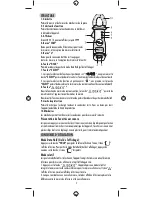
16
3. To exit the Relative mode, press the " " button again.
" " disappears.
Note:
1. The meter will exit autorange mode and stay in the present range when you select
Relative mode.
Measuring DC Voltage
1. Connect the black test lead to the
"COM"
terminal and the red test lead to the "
+
"
terminal.
2. Set the rotary switch to " " position.
3. Connect the test leads across the source or circuit to be tested.
4. Read the reading on the display. The polarity of the red test lead connection will be
indicated as well.
Note:
To avoid electric shock to you or damages to the meter, do not apply a voltage higher
than 600V between terminals.
Measuring AC Voltage
1. Connect the black test lead to the
"COM"
terminal and the red test lead to the "
+
"
terminal.
2. Set the rotary switch to " " position.
3. Connect the test leads across the source or circuit to be tested.
4. Read the reading on the display.
Note:
To avoid electric shock to you or damages to the meter, do not apply a voltage higher than
600V between terminals.
Measuring DC or AC Current
1. Set the rotary switch to " " position. Then press the
"SELECT"
button to select dc
current measurement (" " appears) or ac current measurement ( " " appears ) .
2. If the display does not read zero when the meter is in dc current measurement mode,
press the " " button for zeroing.
3. Press the trigger and clamp the jaws around the conductor to be tested. Make sure that
the jaws are perfectly closed.
Note:
a. Each time only one conductor should be clamped.
b. The conductor should be in the center of the jaws in order to get accurate reading.
4. Read the reading on the display.
Note:
1. Remove all the test leads from the meter before using the meter for current
measurements.
2. After you set the rotary switch to " " position, wait about 5 to 10 minutes before
you proceed. This is necessary for accurate measurements.
Tip:
Current direction is the opposite of
electron flow direction.)
















































